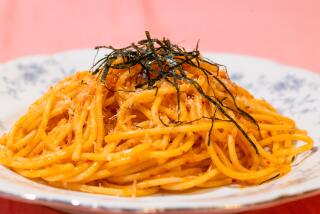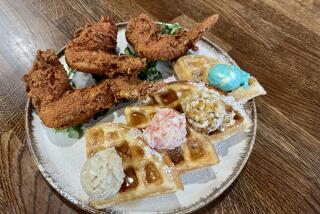Butter warmed to the color of fall
IT’S a brown butter kind of fall.
That is to say, the nutty flavor and butterscotch aroma of butter cooked until it becomes hazelnut brown are turning up on more than a few dinner plates around town -- in sweet corn ravioli and in mashed potatoes at Melisse in Santa Monica, with sweetbreads and a four-spice blend at Spago in Beverly Hills, and in ice cream and financiers at Hatfield’s in Los Angeles.
There’s nothing new about brown butter -- known in French as beurre noisette. It’s just that lately L.A. chefs have been drizzling it, whisking it, incorporating it with uncommon glee.
Quinn and Karen Hatfield, chef-owners of Hatfield’s, love brown butter so much they named the company that owns their restaurant Brown Butter LLC. “It’s a flavor you can’t duplicate, so original, so nutty, so deep,” Karen Hatfield says.
Making brown butter is simple: Melt unsalted butter in a small saute pan over medium heat, cooking it until the water cooks off, then turn down the heat and continue cooking, whisking constantly, until the solids turn golden brown. The whisking ensures even browning. If you have a light-colored pan, that’s the one to use, as it makes it easy to see the browning.
That’s it.
Brown butter is fabulous spooned over roasted kabocha squash, drizzled over Brussels sprouts or steamed cauliflower, or stirred into mashed potatoes.
Add fresh sage and it’s a great sauce for ravioli filled with pumpkin or butternut squash.
Fattening? Yes. But a little goes a long way.
A squeeze of lemon juice turns it into a wonderful sauce for fish. To make any delicate fish fillet or whole small fish a la meuniere (petrale sole, rex sole and trout are all ideal), coat the fish lightly with flour, saute it in a little butter and remove it to a platter. Pour out the butter in the pan, add fresh butter and cook, whisking until it’s brown butter. Whisk in a little lemon juice, pour it over the fish and you’ve got a la meuniere.
Or substitute vinegar for the lemon, add capers and call it an easy, snazzy dinner. (That’s a classic preparation for skate.)
Josiah Citrin, Melisse’s chef-owner, says he loves to use brown butter to finish sauces. He uses it in a Champagne reduction sauce for fish, in a bearnaise sauce and in a balsamic vinegar and brown butter vinaigrette fortified with lobster reduction, which he uses to sauce lobster.
On the sweet side, brown butter stirred into frosting is great for drizzling over cookies or into batters for quick breads. Use it in place of plain butter in the fruit fillings of apple or quince pies for added depth. “Any opportunity I get to melt butter,” says Sherry Yard, pastry chef at Spago, “I continue on to the noisette stage. It adds a wonderful complexity to the dessert.” When making a genoise for a cake she drizzles brown butter in at the end of making the batter.
Scrape vanilla bean into the brown butter and spoon it over poached pears or baked apples. “A whisper of salt makes the flavors dance on the tongue more,” Yard says.
Citrin suggests making a large batch of brown butter, then chilling it in a glass baking dish before cutting it into cubes and freezing it. It’s a convenient way to have brown butter on hand for finishing sauces or adding flavor in an instant.
*
**
Roasted kabocha squash with brown butter
Total time: 1 hour, 10 minutes
Servings: 4
1 kabocha squash
1 tablespoon canola oil
3/4 cup pecan halves
1/4 cup butter
1/4 teaspoon sea salt
4 teaspoons maple syrup
1 teaspoon freshly ground
nutmeg
Fleur de sel
1. Heat the oven to 400 degrees. Cut the squash into quarters and scoop out the seeds. Brush the cut surfaces of squash with oil. Put the squash cut-side down on a foil-lined baking pan. Roast until the squash is fork tender, about 60 minutes.
2. Toast the pecans on a large baking pan until lightly browned, about 6 to 8 minutes. Set aside.
3. In a small heavy skillet, melt the butter over medium heat. Continue to cook, whisking until the butter turns nut brown, 4 to 5 minutes. Mix the pecans with 1 teaspoon of the browned butter and the sea salt.
4. Heat the broiler. Turn the squash quarters upright with the skin side down. Drizzle each baked squash quarter with 1 teaspoon maple syrup. Put the squash under the broiler until the edges of the squash are slightly charred and the syrup has a nice glaze, 3 to 4 minutes.
5. Drizzle 1 tablespoon of the browned butter over each squash quarter, then sprinkle the nutmeg, toasted pecans and a little fleur de sel on the quarters and serve.
Each serving: 346 calories; 4 grams protein; 21 grams carbohydrates; 5 grams fiber; 30 grams fat; 9 grams saturated fat; 30 mg. cholesterol; 109 mg. sodium.
**
Brown butter and quince bread pudding
Total time: 2 hours, 30 minutes
Servings: 8
Note: You will need 8 (6-ounce) ramekins. Challah bread can be substituted for the brioche rolls. Reserve extra butterscotch sauce for another use.
3 quince (about 8 ounces each), peeled, quartered and seeded
3 tablespoons melted butter
2 tablespoons packed brown sugar
3 cups milk
1 vanilla bean, split in half and seeds scraped
6 egg yolks
1 1/2 cups sugar, divided
1/4 cup, plus 2 tablespoons butter, divided
3 (4-inch) brioche rolls, cut into 1/2 -inch cubes (about 5 cups cubed)
1 teaspoon lemon juice
3/4 cup whipping cream
1/2 teaspoon vanilla
Pinch of fleur de sel
Creme fraiche for garnish
1. Heat the oven to 375 degrees. Arrange the quince in a single layer in a 9-by-13-inch baking dish. Drizzle the 3 tablespoons of melted butter over the quince, then sprinkle them with brown sugar. Bake the quince until tender, 45 minutes to 1 hour. Cool the quince, then cut them in a small dice. Lower the oven temperature to 350 degrees.
2. Combine the milk and scraped vanilla bean with seeds. In a medium saucepan, heat the mixture to simmering, then remove the pan from the heat and let the mixture steep about 10 minutes. Remove the vanilla bean and discard.
3. With a whisk, beat the egg yolks and one-half cup sugar until blended. Stir in a little of the milk mixture to temper the yolks, then add the yolks to the saucepan. Heat and stir over medium-low heat until slightly thickened, 8 to 9 minutes. Strain; set aside.
4. In a heavy 9-inch skillet, melt one-fourth cup butter over medium heat. Continue to cook, whisking the butter until it turns nut brown, about 4 to 5 minutes. Toss the bread with the brown butter and toast in a 350-degree oven, about 12 to 15 minutes.
5. Spoon about one-fourth cup of toasted bread cubes into each of eight ramekins. Divide the quince among the ramekins, then add the remaining bread cubes. Pour the milk mixture over the bread in the ramekins pressing to coat the bread. Bake in a water bath (a deep pan filled with enough water to reach halfway up the ramekins) for about 30 minutes until the custard is set. Remove the ramekins from the water bath; cool on a rack.
6. While the bread pudding is baking prepare the butterscotch sauce. Combine 1 cup sugar and one-third cup water in a deep saucepan. Stir over medium heat until the sugar is dissolved. Turn the heat to high and bring the syrup to boiling without stirring. Dip a small brush in water and brush down the sides of the pan to prevent crystals from forming. Continue to cook, gently swirling the pan for even caramelization, until the syrup reaches a deep amber color, 3 to 4 minutes.
7. Cut up 2 tablespoons of butter and heat it with the cream in a small saucepan until it is melted. Remove from heat and stir the hot cream into the caramel until blended. It will bubble up. Stir in the vanilla and a pinch of salt.
8. Serve the bread pudding with a dollop of creme fraiche and drizzle with about a tablespoon of butterscotch sauce.
Each serving with one tablespoon butterscotch sauce and one tablespoon creme fraiche: 450 calories; 8 grams protein; 43 grams carbohy-
drates; 1 gram fiber; 29 grams fat; 17 grams saturated fat; 244 mg. cholesterol; 83 mg. sodium.
**
Petrale sole in brown butter-caper sauce
Total time: 30 minutes
Servings: 4
4 petrale sole fillets, about 3 ounces each
Salt and pepper
1 tablespoon sherry vinegar
1/4 cup butter, cut into small cubes, plus 1 tablespoon, divided
1 tablespoon olive oil
2 tablespoons capers, well drained
1 tablespoon coarsely chopped parsley
1. Rinse the fish fillets under cold water and pat dry on paper towels. Season both sides of fish with salt and pepper to taste and set aside.
2. In a small nonstick skillet, reduce the sherry vinegar by half, about 30 seconds, and set aside.
3. In a heavy medium skillet, heat one-fourth cup of the butter over medium-low heat until melted, about 3 minutes. After the butter melts, begin whisking until it turns nut brown, about 4 to 5 minutes. Remove the butter from the heat and set it aside while preparing the fish.
4. In a large skillet, heat 1 tablespoon butter and the oil over medium heat until hot. Add the fish fillets presentation-side down in the hot skillet and brown 2 1/2 to 3 minutes on the first side, then turn and cook for 30 to 45 seconds. The fish should not be crowded in the pan; if necessary, cook the fillets in two batches.
5. Arrange the fish on serving plates. Sprinkle with parsley. Whisk reduced vinegar, capers and a pinch of salt and pepper into reserved brown butter and spoon over the fish.
Each serving: 225 calories; 14 grams protein; 0 carbohydrates; 0 fiber; 19 grams fat; 9 grams saturated fat; 77 mg. cholesterol; 191 mg. sodium.
**
Brown butter mashed potatoes
Total time: 30 minutes
Servings: 6
2 pounds Yukon gold potatoes
Sea salt
1/2 cup butter, cut into small cubes
White pepper
1/3 cup warm milk
1 tablespoon snipped chives
1. Peel the potatoes and cut them into 1 1/2 -inch pieces. Place them in a 4-quart saucepan and add water to cover the potatoes by 2 inches. Add 1 teaspoon salt and bring to a boil over high heat. Reduce the heat to medium-high and cook until the potatoes are tender, 15 to 20 minutes.
2. While the potatoes are cooking, heat the butter in a heavy 9-inch skillet over medium-heat until melted. Once the butter has melted, whisk until it turns golden brown, about 4 to 5 minutes. Set aside.
3. When the potatoes are tender, drain well. Put the potatoes through a potato ricer or mash the potatoes. Sprinkle over three-fourths teaspoon salt and one-eighth teaspoon pepper. Set aside 2 tablespoons of the brown butter to drizzle over the top. Add the remaining brown butter to the potatoes along with the warm milk. Lightly stir just to combine, being careful not to overmix.
4. Spoon the potatoes into a serving bowl. Drizzle over the remaining 2 tablespoons butter and sprinkle with chives.
Each serving: 256 calories; 4 grams protein; 27 grams carbohydrates; 3 grams fiber; 16 grams fat; 10 grams saturated fat; 42 mg. cholesterol; 310 mg. sodium.


